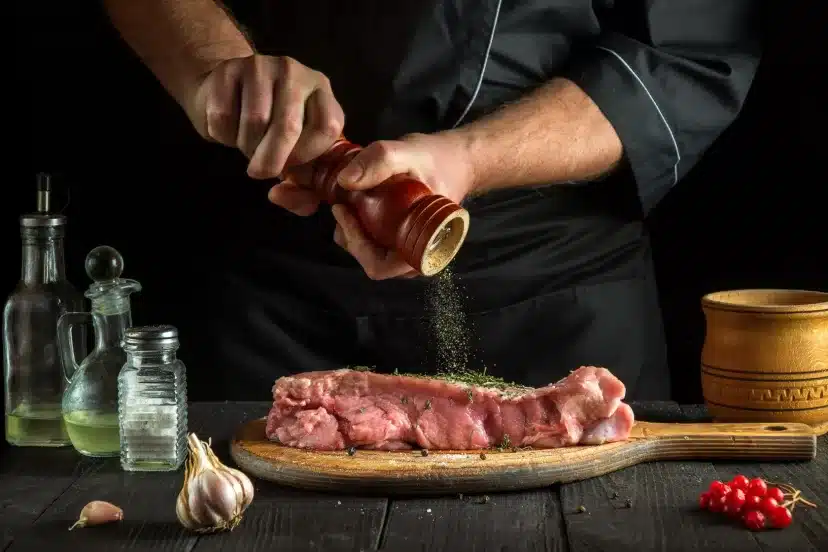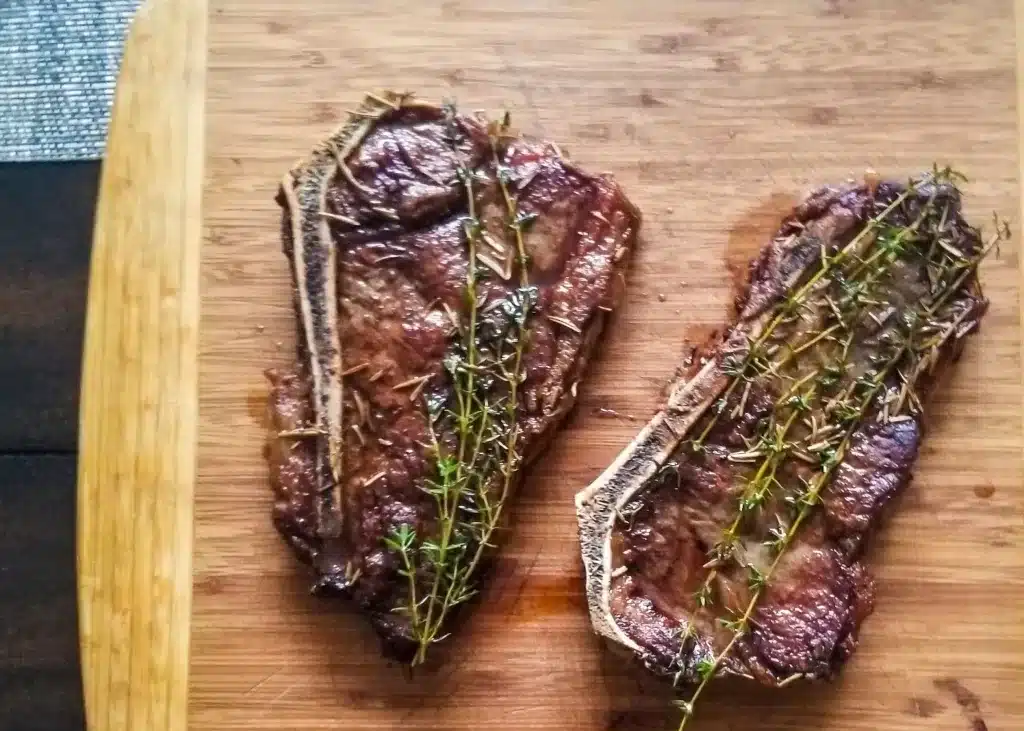How Long to Rest Steak Before Cooking?
Steak lovers, rejoice! The art of resting a steak before slicing and savoring it is often the unsung hero of a truly exceptional dining experience. So, how long to rest steak before cooking?
Although cooking techniques and seasoning play crucial roles, properly resting your steak can elevate its flavor, tenderness, and juiciness to new heights.
In this comprehensive guide, we’ll explore the science behind resting steak, uncover the optimal resting times, and reveal expert tips to ensure you’re serving up a mouthwatering, restaurant-quality steak every time.
The concept of resting meat may seem counterintuitive at first. After all, why would you let a perfectly cooked steak sit idle when your taste buds are eagerly awaiting that first bite?
The answer lies in the intricate science of meat cooking. When you sear or grill a steak, the high heat causes the proteins in the meat to contract and expel moisture. If you slice into the steak immediately after cooking, those precious juices will spill out, leaving you with a dry, less flavorful piece of meat.
By allowing the steak to rest for an appropriate amount of time, the internal temperature and protein structure stabilize, enabling the juices to redistribute throughout the meat. This simple step ensures that every bite is bursting with flavor and moisture, creating a truly unforgettable dining experience.
Table of Contents
Understanding Steak Resting Time
The time needed to rest a steak can vary depending on several factors, including the cut, thickness, and cooking method used. As a general rule, the thicker the steak, the longer it should rest. This is because thicker cuts retain more heat and require more time for the internal temperature to stabilize.
For thinner steaks, such as skirt or flank cuts, resting for 5 to 10 minutes is typically sufficient. Medium-thickness steaks, like ribeyes or strip steaks, should rest for 10 to 15 minutes. And for thick, hearty cuts like tomahawk or cowboy steaks, you’ll want to allow 15 to 20 minutes for proper resting.
It’s important to note that these resting times are just guidelines, and the exact timing may vary depending on your personal preferences and cooking methods. Some chefs swear by resting steaks for as long as 30 minutes, while others prefer a shorter resting period to maintain a piping hot serving temperature.
Preparing for the Perfect Rest
Before you even start cooking your steak, there’s a crucial decision to make: should you cook it straight from the refrigerator or let it come to room temperature first? This debate has raged among steak enthusiasts for decades, and the answer isn’t as straightforward as you might think.
Proponents of the room temperature approach argue that allowing the steak to reach room temperature before cooking helps it cook more evenly, reducing the risk of overcooking the exterior while the interior remains undercooked.
This method is particularly popular for thicker cuts, as it can take a significant amount of time for the center to reach the desired doneness if the steak starts out cold.
On the other hand, those who prefer cooking straight from the fridge claim that the temperature difference between the steak and the cooking surface creates a better sear, developing a delicious crust and locking in more flavor. This camp tends to favor thinner cuts, which cook through relatively quickly.
Ultimately, the choice is yours, but keep in mind that if you opt for the room temperature method, you’ll need to factor in additional resting time to account for the steak’s higher initial temperature.
Once you’ve decided on the starting temperature, it’s essential to consider the resting environment. Ideally, you’ll want to rest your steak on a cutting board or platter at room temperature, away from direct heat sources.
This controlled environment ensures that the steak doesn’t continue cooking or cool too rapidly, both of which can negatively impact the final result.
Resting Techniques
While the basic concept of resting a steak is simple, there are a few techniques that can help maximize the benefits and ensure a consistently delicious outcome.
One popular method is to tent the steak loosely with aluminum foil during the resting period. This helps retain some of the residual heat and moisture, preventing the steak from cooling too quickly. However, be cautious not to wrap the foil too tightly, as this can cause the steak to continue cooking and potentially overcook.
Another technique favored by professional chefs is to rest the steak on a preheated platter or cutting board. This approach helps maintain the steak’s temperature during the resting period, ensuring it stays warm and juicy until you’re ready to slice and serve.
Some adventurous cooks have experimented with alternative resting methods, such as utilizing a warm oven or even a sous vide water bath set to the desired resting temperature. While these methods can be effective, they require precise temperature control and careful monitoring to prevent overcooking or drying out the steak.
Carryover Cooking and Resting
One phenomenon that’s closely tied to resting steak is carryover cooking. This refers to the continued cooking that occurs after the steak has been removed from the heat source due to the residual internal heat.
Carryover cooking can cause the internal temperature of the steak to rise by several degrees, even during the resting period. This is why it’s essential to account for carryover cooking when determining the optimal cooking time and temperature.
For example, suppose you’re aiming for a medium-rare steak with an internal temperature of 135°F (57°C). In that case, you’ll want to remove the steak from the heat source a few degrees below that target, say 130°F (54°C), to account for the carryover cooking during resting.
Failure to account for carryover cooking can easily lead to an overcooked steak, negating the benefits of proper resting. To avoid this, experienced chefs often use a meat thermometer to monitor the internal temperature throughout the cooking and resting process, ensuring they achieve their desired level of doneness.
Cutting and Serving the Rested Steak
After patiently waiting for the steak to rest, the truth has arrived – it’s time to slice and serve! But when is the optimal time to cut into that beautifully rested piece of meat?
Most experts recommend slicing the steak immediately after the resting period has concluded. This ensures that the juices have had sufficient time to redistribute throughout the meat but prevents them from seeping out and causing the steak to dry out.
When cutting, use a sharp knife and slice across the grain of the meat for maximum tenderness. This technique helps to shorten the muscle fibers, making each bite melt-in-your-mouth delicious.
If you’ve followed the proper resting techniques, you should notice an abundance of flavorful juices pooling on the cutting board or platter. Don’t let these precious juices go to waste! Consider drizzling them over the sliced steak or incorporating them into a sauce or gravy to accompany your steak dish.
Benefits of Proper Resting
By now, you’re likely convinced of the importance of resting your steak, but let’s take a moment to recap the numerous benefits this simple step provides:
- Juicier Steak: Resting allows the juices to redistribute throughout the meat, preventing them from spilling out when you slice into the steak.
- Enhanced Flavor: As the juices redistribute, they carry with them the concentrated flavors developed during the cooking process, resulting in a more flavorful eating experience.
- Improved Texture and Tenderness: Proper resting helps the proteins in the meat relax, creating a more tender and enjoyable texture with each bite.
- Better Carryover Cooking Control: By accounting for carryover cooking during the resting period, you can achieve your desired level of doneness with greater precision.
- Easier Slicing: Rested steaks are easier to slice cleanly, ensuring each portion maintains its shape and juiciness.
With so many benefits, it’s clear that resting your steak is a simple yet crucial step in elevating your steak game to new heights.
Common Mistakes to Avoid
Although the concept of resting steak may seem straightforward, there are a few common mistakes that can undermine your efforts and lead to less-than-stellar results:
- Cutting Too Soon: Slicing into the steak immediately after cooking will cause the precious juices to spill out, resulting in a dry and less flavorful piece of meat.
- Resting for Too Long: While resting is essential, leaving the steak to rest for an excessively long period can cause it to cool too much, making it challenging to enjoy the steak at its optimal temperature.
- Resting in an Improper Environment: Resting the steak in a hot or cold environment, or near direct heat sources, can cause it to continue cooking or cool too rapidly, affecting the final texture and flavor.
- Failing to Account for Carryover Cooking: Not considering the effects of carryover cooking can lead to an overcooked steak, even if you’ve rested it properly.
- Overcrowding During Resting: Resting multiple steaks too close together can cause them to steam and lose their crispy sear or crust.
By being aware of these common pitfalls, you can avoid them and ensure that your resting efforts pay off with a perfectly cooked, juicy, and flavorful steak every time.
Expert Tips and Tricks
Although the basics of resting steak are relatively straightforward, there are always opportunities to refine and elevate your techniques. To help you on your quest for steak perfection, we’ve gathered some expert tips and tricks from professional chefs and pitmasters:
- Use a Thermal Cooker: Some chefs swear by resting their steaks in a thermal cooker or cambro set to the desired resting temperature. This method helps maintain a consistent temperature throughout the resting period, ensuring even cooking and temperature distribution.
- Baste During Resting: Periodically basting the steak with its own juices during the resting period can help keep it moist and flavorful.
- Utilize Herb Butters or Compound Butters: While the steak is resting, you can prepare a flavorful herb or compound butter to melt over the top before serving, adding an extra layer of richness and flavor.
- Rest on a Bed of Aromatics: Some chefs recommend resting the steak on a bed of herbs, aromatics, or even sliced onions to infuse it with additional flavors during the resting period.
- Experiment with Different Resting Times: While guidelines are helpful, don’t be afraid to experiment with different resting times to find the sweet spot that best suits your personal preferences and cooking techniques.
Remember, cooking is an art, and perfecting the art of resting steak often involves a willingness to explore new techniques and embrace innovation.
Conclusion
In the pursuit of steak perfection, the importance of properly resting your meat cannot be overstated. By allowing the steak to rest for an appropriate amount of time, you unlock a world of juicier, more flavorful, and tender eating experiences.
Throughout this comprehensive guide, we’ve explored the science behind resting steak, delved into optimal resting times and techniques, and shared expert tips and tricks to elevate your steak game.
Whether you’re a seasoned pitmaster or a backyard grilling enthusiast, mastering the art of resting steak is a skill that will pay dividends in the form of unforgettable, restaurant-quality meals.
So, the next time you fire up the grill or preheat the cast iron skillet, remember patience is a virtue, and resting your steak is the key to unlocking its full potential. Embrace the process, experiment with different techniques, and savor the rewards of a perfectly cooked, juicy, and flavorful steak that will have your taste buds dancing with delight.
*We may earn a commission for the purchases made using our links. Please see our disclosure to learn more.





